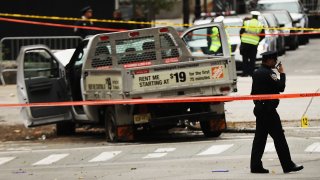
A man who killed eight people along a New York City bike path five years ago left behind a “scene of destruction and horror" where “screams filled the air" before telling an FBI agent he was proud of the destruction he caused and wished the flag of his terrorist group could be put in his hospital room, a prosecutor said at a trial's start.
Assistant U.S. Attorney Alexander Li began his opening statement in Manhattan federal court by recreating the terror attack that he said Sayfullo Saipov carried out on a sunny Halloween day in 2017 with a pickup truck he had rented and accelerated to 66 mph (106 kmh).
As the defendant fiddled occasionally with an electronic device at the defense table, the prosecutor turned briefly to cast a finger in his direction, saying the masked Saipov was to blame for the deaths of the eight individuals and permanent injuries to others.
Later, Saipov's defense lawyer, David Patton, did not deny that his client killed eight people and seriously injured others.
“It wasn't an accident. He did it intentionally," Patton said. “At the end of the day, there is no making sense of such a senseless act."
The lawyer, though, said prosecutors were wrong to claim that Saipov did it to win favor with a terrorist group and he said jurors should pay close attention to the evidence to see he was right.
Get Tri-state area news delivered to your inbox. Sign up for NBC New York's News Headlines newsletter.
Patton said Saipov expected to die that day as a martyr to avenge the deaths of Muslims worldwide.
Li described the scene in which mangled bicycles were strewn along a popular path while survivors “staggered around, wounded and dazed," searching for their family and friends. Among the victims was a family visiting from Belgium and 10 friends from Argentina.
He said Saipov had hoped to kill even more people by driving to the Brooklyn Bridge, “where he could mow down even more people.”
Saipov, 34, who has pleaded not guilty, was charged in the attack after he crashed his truck into a school bus, leaving one child with serious brain damage, Li said. He emerged from the truck with a pellet gun and a paintball gun and shouted an Arabic phrase, “Allahu akbar!” meaning “God is great!”
Li said Saipov meant the shout to be “celebratory." He was shot by a police officer and arrested at the scene along the West Side Highway.
Li said the police officer will be among witnesses who will recount the events of that day, along with an FBI agent who Saipov reportedly asked to display an “ISIS" flag in his hospital room.
“He was proud of his attack. He told an FBI agent that his goal was to kill as many people as possible," the prosecutor said, adding that the agent will testify that Saipov smiled as he recounted his destruction.
The trial comes after a six-month-long jury selection process aimed at weeding out those individuals who cannot be impartial.
Judge Vernon S. Broderick has told them that if Saipov was convicted, a separate “punishment phase” of the trial would occur in which the jurors would be asked to decide whether Saipov should spend life in prison or be executed. Unless they unanimously chose death, the sentence would be life in prison, Broderick said.
Saipov's lawyers have said the death penalty process was irrevocably tainted by ex-President Donald Trump when he tweeted in all capital letters a day after the attack that Saipov “SHOULD GET DEATH PENALTY!”
In 2001, just weeks before the Sept. 11 attacks, a jury in Manhattan federal court declined to impose death on two men convicted in the deadly bombings of two U.S. embassies in Africa.
In 2019, Saipov spoke out during a pretrial hearing, saying “thousands and thousands of Muslims are dying all over the world" and questioning why he should be judged for eight deaths.
In his opening statement, Li said jurors will hear testimony about Saipov's desire to win the favor of the Islamic State group after he moved to the United States legally from Uzbekistan in 2010. He lived in Ohio and Florida before joining his family in Paterson, New Jersey.
The prosecutor said Saipov’s cellphones contained proof that he viewed and stored thousands of images of Islamic State propaganda, including calls to use cars and trucks as weapons in terrorism attacks in the United States.


